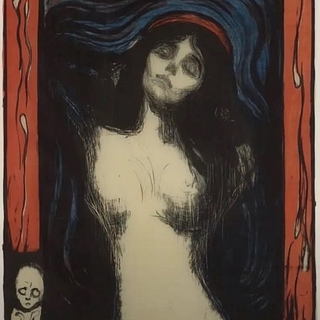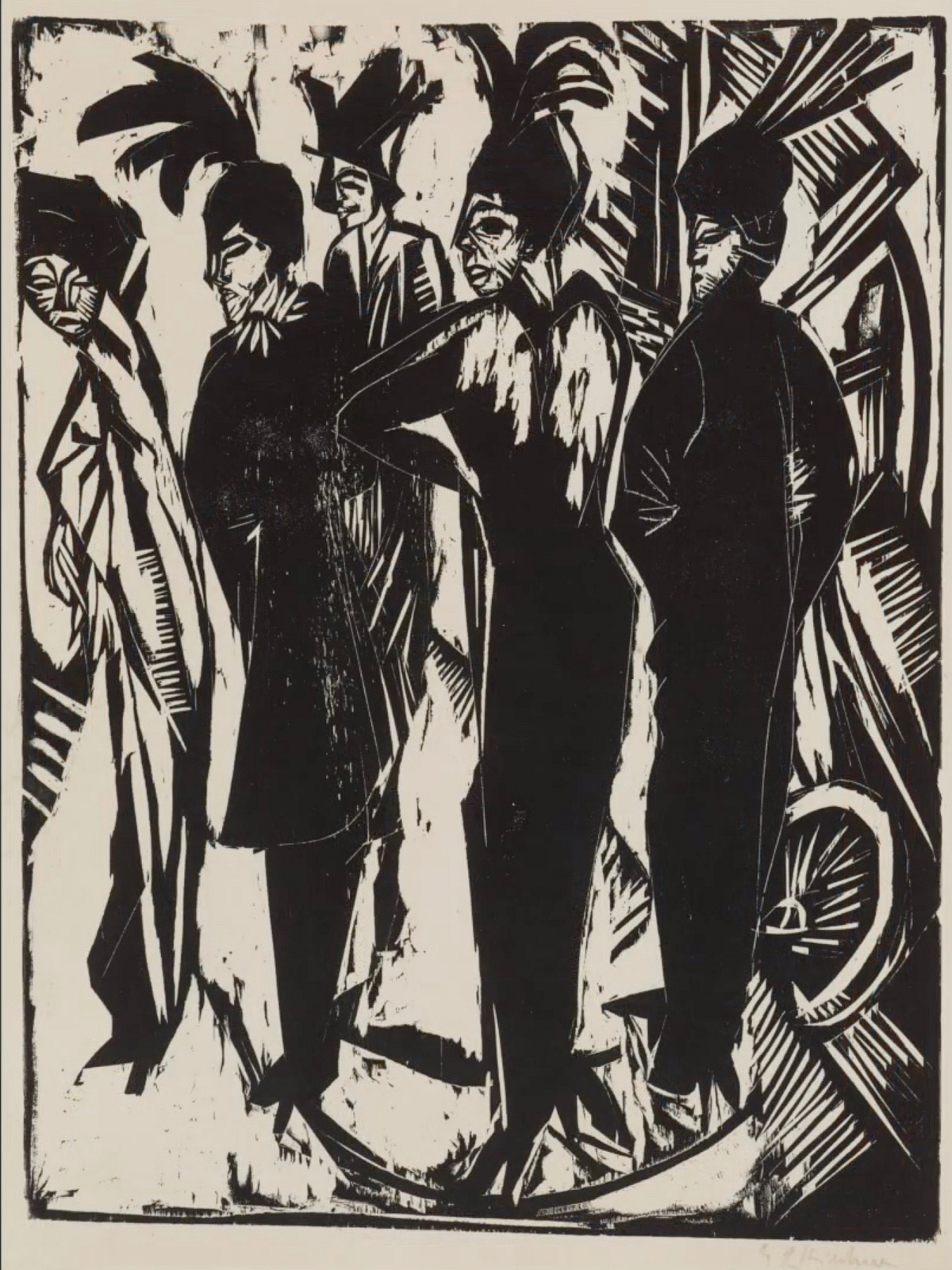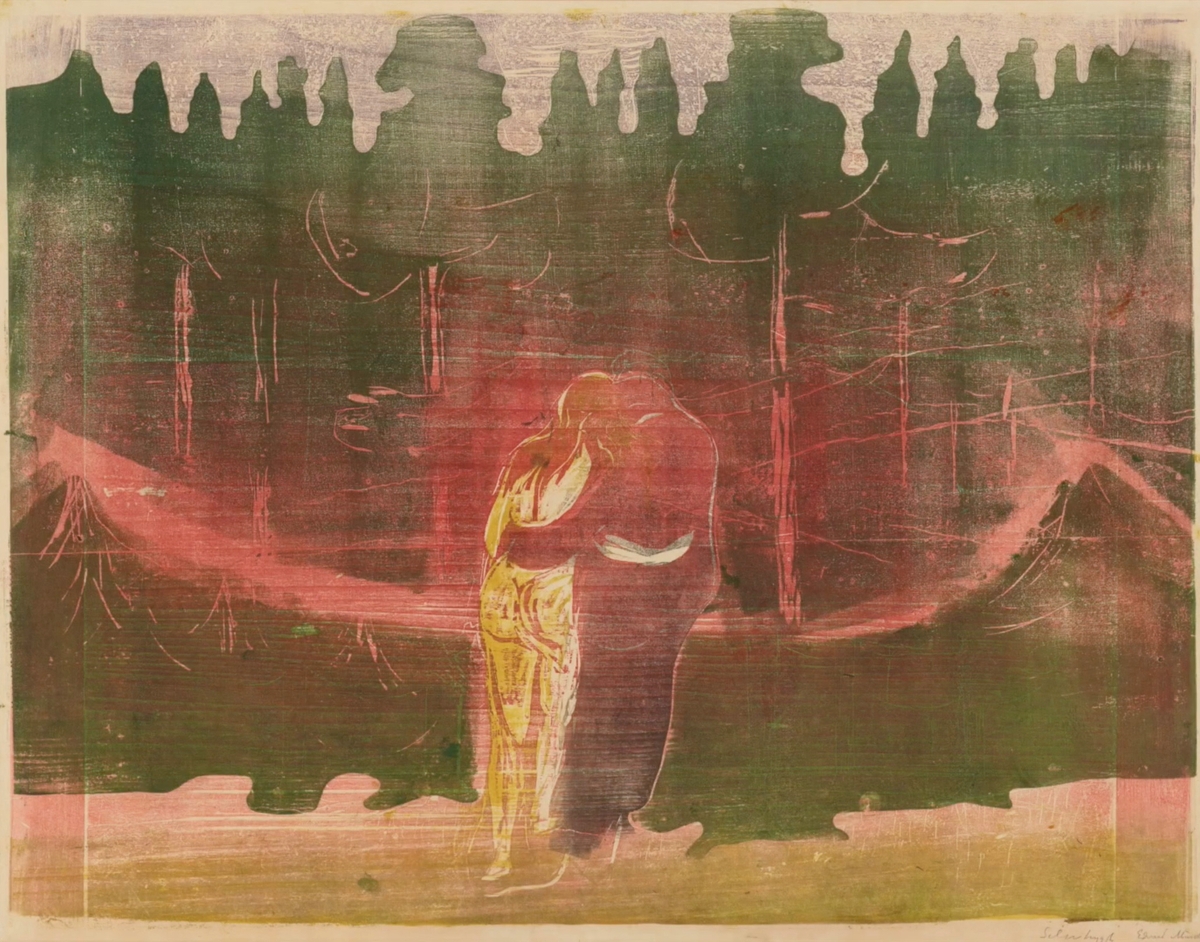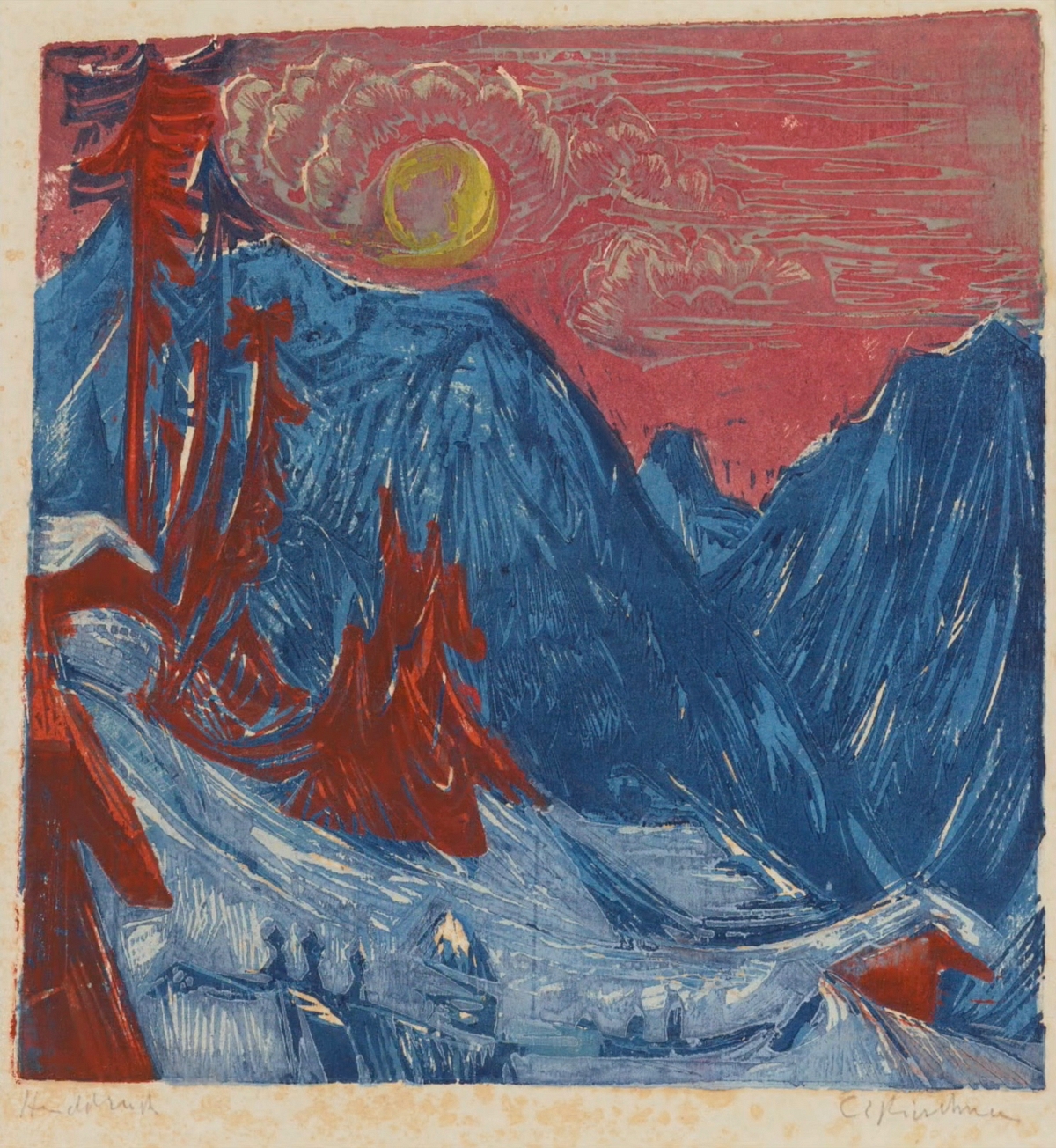
Madonna.
The Yale University Art Gallery’s show “Munch and Kirchner: Anxiety and Expression” — running now through June 23 on the gallery’s fourth floor at 1111 Chapel St. — begins with a moment at an art gallery over 100 years ago that feels like it could happen today, or any time. In 1912, the text relates, there was a “monumental exhibition of modern art” in Cologne, Germany that “aimed to illustrate how the most cutting-edge groups of the day drew inspiration from the work of a slightly older generation.” That big-tent approach, however, turned out to be fraught.
The Cologne show positioned Edvard Munch — now immortalized thanks to a single work he produced, The Scream, but at the time a living, working, and high-profile artist — as “a bridge between artistic styles, moving toward Expressionism.” Munch, in short, was part of the older crew. Ernst Ludwig Kirchner, nearly two decades his junior, was part of the younger crew.
“Munch and Kirchner met in the galleries and took a brief stroll together through the show. Even though they shared friends, dealers, and patrons, this was their first and last amicable encounter. The younger and extremely ambitious Kirchner repeatedly tried to distance himself from Munch, declaring, ‘He is the end, I am the beginning.’ ”
On one level, the anecdote is a funny and classic illustration of the narcissism of small differences, a term Sigmund Freud would define five years after the Cologne show. As the accompanying text relates, Munch and Kirchner overlapped in their lives, artistic styles, and themes. “Both artists worked in an Expressionist mode; in their art, rather than replicating what they saw in the world, they filtered everything through their own feelings, memories, and imaginations. Both were also pioneering printmakers, eschewing the mastery of any single technique for experimentation across many.” With bold lines and vivid colors, “they portrayed what they perceived to be a fragmented, harrowing reality — for themselves and for society more broadly, as Europe faced fiercely divided politics, war on an unprecedented scale, and various issues born from industrial capitalism.”
The parallels continue, as both artists also represented “their acute struggles with mental health and physical debilitation. They each endured bouts of depression, grappled with substance abuse, and received psychiatric care. They thematized illness as a universal and deeply affecting human experience.”
By placing the artists in close but tense proximity to one another, the show — curated by Freyda Spira with assistance from Joseph Henry — places both the artists and their works in clearer, more vivid focus. For many viewers, the show will mean an exploration of Munch’s work beyond The Scream, and an introduction to the equally absorbing work of the lesser-known Kirchner. The juxtaposition also has the effect of making their concerns utterly contemporary. In their concerns for politics and mental health, Kirchner and Munch both emerge as completely relevant artists with a lot to say about our own time.

Ernst Ludwig Kirchner
Five Coquettes on the Street.
It’s perhaps obligatory that the show begins with The Scream, but even in its layout, the show encourages viewers to move quickly past it. It’s fair to say that The Scream has been thoroughly digested by culture, while at the same time it retains much of its power to unsettle. But there’s not much left to say about it at this point, even if this reporter’s favorite (faintly ridiculous, totally unprovable, yet fun) pet theory about it is that the vivid sunset in the painting isn’t just an expression of the painter’s inner turmoil, but also an accurate portrayal of the sky over Oslo after the cataclysmic eruption of Krakatoa in 1883.
The show’s first segment, focusing on “woman/love/death and anxiety,” already begins to provide illuminating context. Both artists, a note explains, “understood modern art as something that could contest the strict moral codes and conformist attitudes of modern life.” These struggles “played out in the arenas of gender and sexuality amid larger social debates about gender equity, marriage, free love, and sex work” — at that time, even more fraught with the prevalence of venereal diseases than it is now. “Against this background, Munch and Kirchner explored representing women as symbols of either innocence or corrupted eroticism, around which sensations of violence, fear, and desire coalesced.”
If this sounds dramatic, it was. As Munch wrote about the subject of his Madonna — a work that, like The Scream, he made several versions of — “your face encompasses the beauty of the whole earth. Your lips … gently part as if in pain. It is the smile of a corpse. Now the hand of death touches life. The chain it forges links the thousand families that are dead to the thousands of generations to come.” The sentiments in Munch’s overheated prose work much better as visual art. And as the exhibition cannily points out, these feelings were being worked out in a larger social context.
In the next section, entitled “City,” the curators relate that Munch was part of a “circle of bohemian artists and writers and often portrayed them in risqué, even scandalous scenes.” Both Munch and Kirchner also spent time in Berlin, “where they immersed themselves in the growing artistic and intellectual worlds centered in cafes and theaters.” Berlin’s “unremitting nightlife, with its sexual freedoms and general ethos of pleasure-seeking, inspired ennui and excitement in equal measure.”
Of the two, Kirchner proved to have a keener eye for street life. Some of his pieces, like Five Coquettes on the Street, work as both documents and as emotional reactions. The women are indisputably sex workers, but Kirchner doesn’t let us see them as easy objects of desire. He creates ambivalence, complication. The spirit of Berlin may have been one of hedonism, but Kirchner’s piece leaves room to question that hedonism. How pleasurable was it really? What were its consequences?

Ernst Ludwig Kirchner
Nervous People at Dinner (Kohnstamm Sanatorium).
Part of those questions rests within an even broader context of what the curators categorize as “illness” — an entire section unto itself in the exhibition and a major theme throughout. They quote Munch’s famous expression that “disease, insanity, and death were the angels that attended my cradle and have followed me throughout my life.” He lost his mother and a sister to tuberculosis and was often in poor health himself. As he struggled with what he called “frayed nerves,” another of his sisters was committed to a psychiatric facility. Kirchner also had “complexly intertwined mental and physical ailments … exacerbated by his failed military service in World War I.” Again the curators point out the parallels while highlighting the tension. Both went to sanatoria, clinics, and spas and had several doctors, yet Kirchner still found time to call Munch a “feeble hypochondriac.”
Among the many sad, poignant pieces by both artists in this section of the show is one that showcases some of Kirchner’s complex wit. Nervous People at Dinner portrays a scene at a sanatorium; “private clinics often encouraged abundant meals for the health of their patients,” the curators’ note explains. Kirchner had trouble with this, feeling “constantly disturbed,” in his words, “by the treatment and eating and by the other inmates.” Again, he placed himself apart from his subject to cast a critical eye on it.

Edvard Munch
Toward the Forest I.
And in the end, both artists also found time to connect with nature in their later years — Munch in the wilder places in Norway, Kirchner in the Swiss mountains. “The landscapes to which Munch and Kirchner looked are spaces of melancholy, loneliness, and physical separation but also of healing, interconnectedness and vitality,” the curators write.
Munch made several versions of Toward the Forest, experimenting with color and form. He thought of forests as “living, breathing, even holy places.” In his own description of the piece, he wrote of the figures that “they went into an opening in the forest — on both sides stood tall conifers and birches — lush and dark against the twilight evening air. … They walked up and silently, heads bowed — they were enveloped in an atmosphere of solemnity, as though in church.”

Ernst Ludwig Kirchner
Moonlit Night, Winter.
Munch’s ability to be carried away remains intact throughout. The woods, it turns out, even dimmed Kirchner’s penchant for more complex judgments. Of the subject of Moonlit Night, Winter, he wrote to a friend that “there was such a wonderful moonset before sunrise this morning, the mountain all blue, the sky reddish violet with pink clouds, and the yellow crescent moon.… It was simply madly beautiful, but terribly cold.” It seems fitting that both artists, who used their art to plunge headlong into the personal, physical, psychological, and social problems of their day, also found solace in removing themselves from it all.
“Munch and Kirchner: Anxiety and Expression” runs at Yale University Art Gallery, 1111 Chapel St., through June 23. Admission is free. Visit the museum’s website for hours and more information.


I learned something very important when I went to the Munch Museum in Oslo. The name is pronounced Munk, not Munch. (The museum is excellent, showing the work of Munch throughout his career, as well as that of his contemporaries.)